5.1 Processing Of Cassava
5.2 Processing of other Root and Tuber Crops
Chapters 2 and 3 discussed the high moisture content characteristic of roots and tubers which makes them difficult to store for any length of time. Also they are bulky and difficult to handle and transport to distant markets. With cassava these problems are increased by compounds of cyanide in the leaves and roots which have to be removed before they can be consumed. Over many years traditional processes have evolved which yield a more durable product and in many instances a more convenient product for domestic use. In many village communities root crops remain a staple and hence are often the main part of the meal. Village scale processing of root crops is therefore an important part of women's daily work. This chapter describes the substantial efforts that have been made to upgrade local processes, but many communities still only have access to traditional methods which although appropriate are laborious. Commercial processes are being developed, often based on traditional operations, to bring processed roots and tubers to a world wide market.
The more important traditionally processed products include dried chips and flours, and in the particular case of cassava, non-gelatinized flours, both fermented and unfermented, fermented pre-gelatinized grits and pre-gelatinized flours.
5.1.1 Production of dehydrated chips
5.1.2 The processing of cassava into gari
5.1.3 The processing of cassava into "farinha de mandioca"
5.1.4 The production of cassava bread
5.1.5 The production of attieke
Cassava is the most perishable of roots and tubers and can deteriorate within two or three days after harvesting (see section 4.1). Additionally, the roots need to have the cyanogenic glucocides reduced to a level which is acceptable and safe for consumption. For these reasons cassava is usually sold as a processed product whilst other roots and tubers are most frequently sold as fresh produce. Appendix 5.1 lists some of the traditional foods produced by processing cassava but this discussion is limited to the more popular cassava products, notably gari, farinha, cassava bread and attieke.
Traditionally, the bulk of cassava products are processed by women at village level, working independently or organized into informal groups or cooperatives. These women have developed an empirical knowledge of the physical and chemical characteristics and the functional properties of the cassava starch. The traditional processing techniques are laborious; washing, peeling, resting, fermenting and heat treatments are typical of the processes used in the production of gari in Ghana and the fu-fu flour in Benin. As well as producing food for domestic consumption, cassava processing is a rural enterprise which adds value to the product and increases the marketing opportunities for small and semi-subsistence farmers. More recently in many areas there is a tendency for the women's' role to be displaced with the introduction of mechanisation. For example in West Africa the introduction of mechanised graters had greatly improved the productivity of gari processing, making this an attractive economic activity to both men and women, so that the farming of cassava, once a "women's' crop", has repeatedly been taken over by male members within a household, leaving the females having to look for alternative opportunities for their personal income.
Processed cassava products can be divided into two main groups:
· Dry products; (chips, gari, farinha, cassava bread). These are generally the least time-consuming to produce and the most practical processed form, with a longer storage shelf life. They are also the most economically remunerative for the processors· Moist products; (attieke, chikwangue, batons). These take longer to prepare than the dried product, in some cases much longer, and their shelf life is relatively short.
Dried cassava chips or sticks are produced in many African countries. The production method is simply slicing or cutting the roots into pieces and drying them in the sun. When bitter varieties (see section 1.4.1.2) are used to make the chips they are normally soaked in water for one to three days, either before or after slicing. Dried cassava pieces are known as kokonte in Ghana, lafun in Nigeria, etho or dombe in Sierra Leone and njambo in the Gambia. The following operations are carried out in their production
5.1.1.1 Peeling
Cassava must be peeled to remove the inedible outer parts of the root consisting of the corky periderm and the cortex (see Figure 1.1). These are known to contain most of the toxic cyanogenic glucosides, the ratio of glucocides compared to the starchy flesh varying between 5-10 : 1. Hence, for a root composed of 15% peel with a total cyanide content of 950 mg/kg (fresh weight basis) and 35 mg/kg in the flesh, 83% of the total cyanide is removed by peeling (Bencini, 1991). (See also section 1.4.1.2)
At the village level, peeling is usually done manually using a knife. In varieties which are easy to peel, the peel is slit along the length of one side of the root and the knife-blade and fingers are used to roll back the peels from the fleshy portion of the root. In more difficult varieties to peel, the two layers of peel are whittled with a knife in a motion reminiscent of sharpening a pencil. This operation is less satisfactory as it usually results in the removal of some flesh along with the peels and some of the peels are left on the root.
Hand peeling is slow and labour intensive but it still yields the best results. The output of one person is about 25 kg/hour of peeled roots with a loss of 25-30% of weight in the peels (Bruinsma et al. 1983). Many attempts have been made to upgrade the peeling operation by using simple machines or by chemical action but many are reported to be ineffective and wasteful. Hot solutions of sodium hydroxide (Lye) can be used to loosen the skin to facilitate later peeling, such as removal by water spray or scrubbing with brushes. The desired effect can be obtained by a careful combination of lye concentration, temperature and time of immersion. But, the process is anything but simple and is more appropriate for small commercial operations.
Table 5.1 Examples of processed cassava (Adapted from: Muchnik and Vinck, 1984)
|
Name of Product |
Country |
Aspect of the product |
Length of storage |
|
Chips |
Nigeria Cameroon Benin Togo Ghana |
Small pieces of sun-dried cassava sometimes fermented, and marketed before being ground into flour. The flour is mixed into paste with hot water to form a thick, sticky mass known as "fufu" in West Africa or "ugali" in East Africa. |
Several months |
|
Gari |
Nigeria Ghana, Togo, Benin, Cameroon |
A dry fermented and gelatinized coarse meal. It is mixed into a paste with hot or cold water and eaten with soups or stews. Also used as snack when mixed with milk and sugar. |
Can be stored for up to 2 years if kept below 12% mc |
|
Farinha |
Brazil |
A yellowish coarse meal very similar to gari. It is used in many Brazilian dishes, especially in the north-east region. |
Several months or if kept dry for up to 2 years |
|
Attieke |
Côte d'Ivoire |
Attieke resembles wet "cuscus". A fermented, pre-gelatinized meal generally consumed with milk or meat and vegetables. It swells much less than gari and farinha. |
3 to 4 days |
|
Cassava bread |
Haiti, Dominica Rep. Venezuela,. |
A white, flat, circular, light textured bread baked from moist cassava pulp. Thickness varies from 1 to 5 mm and diameter from 10 to 90 cm. Called casabe in Spanish, cassava in French and beiju in Portuguese |
One week |
|
Chicouangue |
Congo Zaire Central African Rep. |
A pre-gelatinized cassava paste usually in the form of balls wrapped in leaves. |
3 to 4 days |
|
Baton |
Cameroon Congo Zaire Gabon |
Basically a fermented and pounded cassava mash but with wide regional variation Often shaped as 30-50 cm long and 2 to 4 cm diameter sticks. They are tied in leaves for cooking, they may be eaten alone or with a side dish. |
Few weeks |
|
Fufu |
Cameroon Congo Zaire |
The name used for the paste made from cassava starch, flour and grated roots. |
3 to 4 days |
5.1.1.2 Chipping
The objective of chipping is to expose the maximum surface of starchy flesh and encourage a rapid drying. Villagers have learned that the best drying, in terms of quickness and quality of the end product, is achieved when the peeled cassava is thinly sliced. Not only are thick pieces more difficult to dry, the surface will dry whilst the inside is still wet and because of the dried outer cells have shrunk the rate of moisture diffusion from the inside is greatly reduced and the time of complete drying considerably extended.
The shape of the chip influences how fast it dries. Because cassava chips are white they reflect much of the sunlight that falls on them. Hence in sun-drying systems the chips are dried more by the passage of air over them than by the direct effects of the sun's rays. The initial drying of the chips occurs as the water on the chip surface evaporates and is then replaced by water vapour diffusing from the inner layers of the chips. Although diffusion and the rate of drying are fastest in small chips, when they are in a thick layer they can easily become compacted, which prevents free air movement through the mass. As a result, for effective drying the chip's shape should permit air to readily pass through a large mass of chips. The optimal chip geometry for natural drying is a bar 5 x 1 x 1 centimetres (Cock 1985).
The tool used by villagers is often only a heavy knife with which it is difficult to make slices sufficiently thin for rapid drying. As the operation itself is tedious and there is always the risk of the operator cutting their fingers, pieces are usually thick, more than 10 mm. Notwithstanding, hand chipping is still adequate where only up to 50kg of roots are dealt with in one day.
A number of small mechanical cutting machines have been developed to improve chipping. The Department of Agricultural Chemistry and Food Science in the Philippines3 has designed a simple slicer which is said to cut sweet potatoes much faster and of a more consistent thickness than manual methods and is claimed to be equally successful with cassava. The roots are held on a cutting platform against a plate which controls the thickness of the slice. Slices are then cut off with the pivoting blade (Figure 5.1). Other designs include a metal blade mounted in a framework or a metal disc which incorporates a cutting blade, both types being rotated by hand or powered by peddling a bicycle type mechanism. Figure 5.2 illustrates a hand operated cutter developed by CIP. The root is pressed down against the disc with one hand whilst the other hand turns the handle and rotates the disc. P.T. Kerta Laksana of Indonesia4 has made a pedal-driven sliced fitted with one large slicing blade which is claimed to have a capacity of up to 500 Kg per hour. All these machines produce thinner and more uniform slices than chipping by hand.
[3 Reported in Root Crop Processing (1993) Food Cycle Technology Books, Intermediate Technology Publications Ltd. London.4 ibid]
Figure 5.1 Simple chipping devices
Philippines Root crop slicer
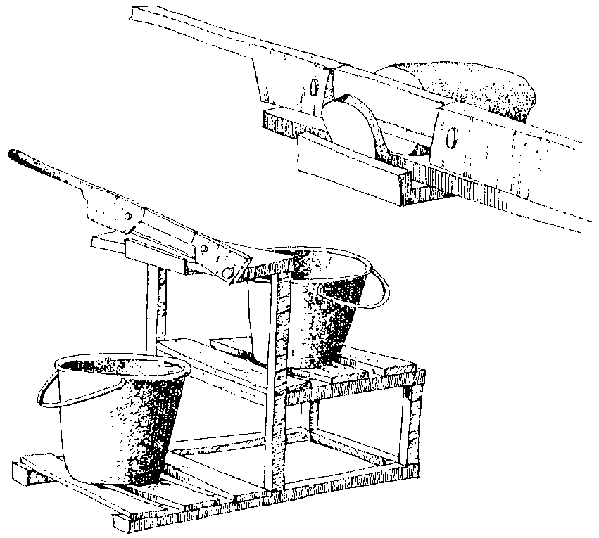
Indonesian pedal operated cassava slicer
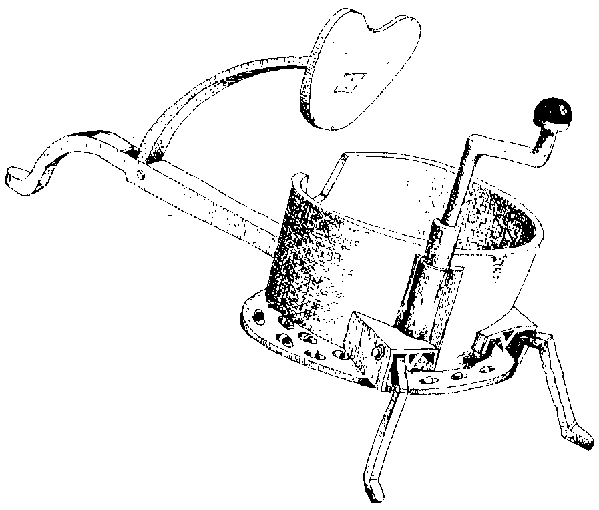
CIP potato cutter

5.1.1.3 Soaking
Soaking in water is often done for one to three days, either before or after the chipping operation during which some fermentation takes place that gives the chips the sour flavour favoured by some consumers. Soaking also allows residual hydrocyanic acid in the cassava to diffuse out, making the product safer for human consumption. The National Root Crop Research Institute in Nigeria suggests that optimal hydrocyanic acid reduction can be achieved through a combination of 15 minutes soaking and 2 minutes blanching of the cassava chips.
5.1.1.4 Drying
Sun-drying of cassava chips is carried out on any convenient flat surface; on roofs, concrete surfaces, mats or along road-sides. The objective is to produce dry cassava chips which are clean, have a white colour, are free from extraneous matter and can be safely stored for long periods. Many factors affect the rate of drying of cassava chips:
· thickness of the slices;
· the loading rate, i.e. quantity of chips per unit area of drying surface;
· air temperature and relative humidity, and;
· wind speed.
With traditional sun-drying little can be done to change or control the conditions of wind, which affects air movement over the chips, the air temperature or relative humidity. During the drying process there are two discrete phases; in the first phase the chips lose moisture very quickly down to about 20% mc, wind speed passing over the chips is more important than air temperature and relative humidity. Under cloudy weather or even at night, the first drying phase can be completed so long as there is sufficient air movement through the chips. In the second phase drying is much slower and needs a relative humidity of not higher than 65% to dry the chips to a moisture content of 13% which is considered safe for long term storage. Except during periods of actual rain, in most places the temperature will increase sufficiently during the day to reduce ambient humidity to the required level to complete this second stage of drying.
This explanation underscores the difficulties of drying chips during the rainy season when the relative humidity of the air is frequently above 80% and when drying the chips may take several days. Contamination then becomes a major problem, from the growth of microorganisms, toxins developed by microorganisms of which aflatoxin is a notorious example, insect eggs, faeces and detritus. Discolouration of the chips detracts from their appearance and noxious odours and off-flavours are unacceptable to the consumer. Improved drying methods for chips which reduce the duration of the drying period to a maximum of two days would be a great advantage
A combined research programme by The Asian Institute of Technology, the NRI and CIAT has shown that drying rates can be greatly improved by placing the cassava chips in suspended trays with a bottom of wooden slats or chicken wire. The trays allow more air to flow through the mass of the chips and eliminate the need to turn the chips periodically. With careful scheduling the time to dry cassava chips can be held to 24 hours. Cassava chips made during the day should be loaded onto the trays in the late afternoon. During the night, even though the relative humidity may be high, the chips lose moisture. On the following day the difficult final drying to about 13% mc occurs during the early afternoon when the relative humidity is lowest (Cock 1985).
The use of solar dryers could constitute a major improvement on the drying of cassava chips (Figure 5.2). Solar dryers of the cabinet type and of the hot-house types are reported to be in use in Nigeria. The cabinet type, often referred to as a Brace dryer, is usually a wooden structure covered with plastic sheets which form the solar collector. On days with adequate sunshine, average temperatures are of the order of 65° to 75°C, which is suitable for a variety of products, such as vegetables, grain, meat as well as cassava chips. While this type of dryer is cheap to construct and have been tried in many situations around the world they so not seem to have achieved wide acceptability. The hot-house type is a passive direct-gain system, which can be built with burnt bricks or mudblocks, transparent sheets and black paint; and of any size to suit a farmer's needs. Drying temperatures vary between 40° and 60°C.
Figure 5.2 a Brace solar dryer
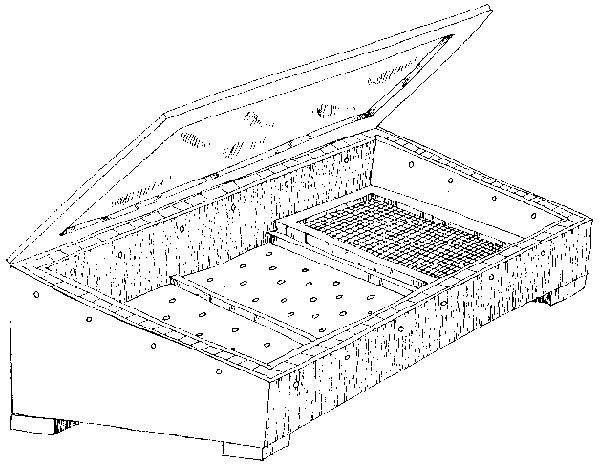
Figure 5.2 b Cassava drying in a hot house solar dryer
Wood fired dryers also represent a simple drying technique which can alleviate the constraints of drying chips during the rainy season (Figure 5.3). One of the first to be developed was the Brook drum dryer which is basically a large tray supported on a block or mudbrick base which has air inlets in its sides. A flue made of empty 200 litre metal drums passes under the tray through which hot air flows from a firebox to a chimney. Air entering the side inlets is heated by passing over the metal drum flue. Natural convection creates enough pressure differential to move the heated air through the drying crop without any mechanical device. This type of drier is not very efficient in its use of fuel and was designed when firewood was cheaper and more plentiful than nowadays. Although this type of dryers may be beyond the financial reach of most farmers, they may be suitable for cooperatives or groups of women processors.
Figure 5.3 A kiln type dryer, the Brook dryer
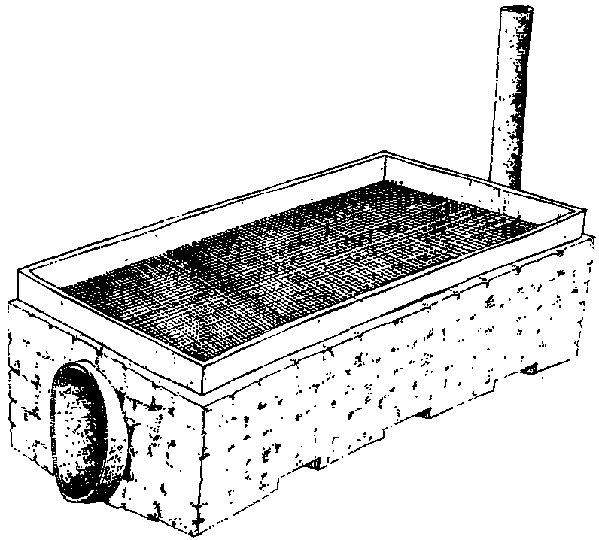
5.1.1.5 Storage of the dried chips
Once the chips are dried to a moisture content of 13% or lower they can be stored for several months, provided they are kept dry, and particularly are not exposed to high ambient relative humidities. Cross-infestation by insect and pests from other stored products is to be avoided. In West Africa the chips are sometimes parboiled before drying them which is considered to enhance the storability of the chips. Polyethylene-lined jute bags have been used successfully to store dried cassava chips.
Gari is a fermented and gelatinized dry coarse flour, very popular in West Africa and a staple food in Nigeria, Ghana, Benin and Togo. Its ability to store well and its acceptance as a "convenience food" is responsible for its increasing popularity in the urban areas of West and Central Africa. It is often consumed as the main meal in the form of a dough or a thin porridge. Both are prepared in the household by mixing dry gari with hot or cold water and cooking and are served with soup or stew. Gari is also eaten as a snack when mixed in cold water with sugar, and sometimes milk. It swells three to four times its volume when mixed with cold water.
The traditional production of gari is a long and tedious process. Five distinct operations are required: peeling, grating, fermentation and pressing, sieving, frying and drying (Figure 5.4).
Table 5.2: Operations in the production of gari and the losses incurred at each operation from an initial 100 kg of fresh unwashed roots
|
Operation |
Loss of material |
Residual MC % |
|
Peeling and washing |
27 kg peel |
70 |
|
Grating |
3 kg |
70 |
|
Pressing/Fermentation |
30 kg |
96 |
|
Sieving |
1 kg |
50 |
|
Frying/drying |
17 kg |
8 |
|
Residual Gari |
22 kg |
|
These operations are traditionally carried out entirely by women, usually starting very early in the morning harvesting, peeling and washing the roots in the field, then carrying the cleaned roots to the village where the rest of the operations are carried out.
5.1.2.1 Grating
The grating operation is usually carried out manually, but power-operated graters of various makes and models are being more widely used
- Traditional method
Hand grating is invariably considered the most tedious and painful operation of the whole process. The women who still grate the cassava manually, when asked about the problems of gari processing, will simply show the palms of their hands. To hand grate one tonne of fresh peeled cassava roots generally requires 10-15 man days of effort. (Cock 1985).
The cassava is usually grated at least one hour after washing in order that excess water can drain off the peeled and washed cassava, otherwise the roots are too slippery and too difficult hold during grating. The manual grater is usually only a piece of galvanized metal sheet or even a piece of flattened can or tin, punched with about 3mm diameter nails leaving a raised jagged flange on the underside. This grating surface is fixed on a wooden frame (Figure 5.4) and the cassava pieces are pressed against the jagged side of the metal and rubbed vigorously with strong downward movements. Particular care has to be taken and some skill is required "not to also grate the fingers" but still accidents sometimes happen. This traditional technology can be improved by mounting the grating surface on a wooden table at a convenient height so the rubbing action is horizontal rather than in a downward slant when the grating surface is supported against the operators legs It is not possible to completely grate a whole cassava piece, 3% to 5% of the cassava has to be left ungrated (Flach 1990, Bencini 1991). A skilful person is able to produce only about 20 kg/hour. In 1990 manual graters were sold for US$2 to $3 each in village markets of the north-west province of Cameroon (Flach, 1990).
Figure 5.4 The traditional grater - fabrication and use (Muchnick and Vinck, 1984)
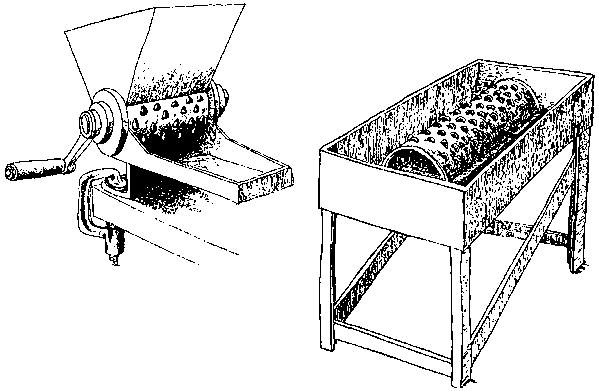
- Mechanized grating
Sometimes a group of processors will purchase their own mechanically powered rasping or grating machine or a private contractor will travel within a group of villages grating cassava for a fee. There are two types in common use: i) modified hammer mills and ii) graters using an abrasive disc. The abrasive surface can be either cylindrical or a flat disc (figure 5.5) and is frequently a galvanized metal sheet with nail-punched holes, as in the hand grater, and attached to a wooden frame. It is said the grating surface normally wears out with six months of regular use and must be replaced otherwise the output of the machine is significantly reduced. One further disadvantage with this rudimentary grating surface is the difficulty of cleaning it after use. Debris becomes lodged in the holes and within the torn flanges and becomes a substrate for microbial growth and the possible subsequent contamination of the grated cassava which could affect the subsequent fermentation.
Many of the simple graters in use have been developed by local institutions. In the early 1970s a cassava grater was developed in the Intermediate Technology Development Group's workshop in Nigeria made from simple workshop spare parts and using hacksaw blades mounted on a vertical disc. It was driven by somebody peddling. The "Wadwha" disc grater was developed in vertical disc. It was driven by somebody peddling. The "Wadwha" disc grater was developed in Ghana and consisted of a disc shaped wooden block to which a perforated metal sheet was nailed. The disc was driven by a 5 hp diesel engine and a throughput of one tonne of cassava was claimed. The Tikonko Agricultural Extension Centre in Sierra Leone developed a vertical drum grater. The outer surface of the drum was covered with a sheet of perforated metal and as it rotated the cassava was pressed against the grating surface by a wooden block. The drum was powered by a 4 hp electric motor or diesel engine. In general capacities range between 300kg to 1,000kg per hour (Bencini, 1991). In Cameroon many of the cylindrical power graters used in villages are based on the design of CENEEMA which has some unique design features intended to improve grating efficiency and output without necessarily increasing the power requirement. There are, however, many variations in design, power transmission, capacity and type of construction. (Fig 5.5).
Figure 5.5 Simple mechanized graters
Wadwha disc grater
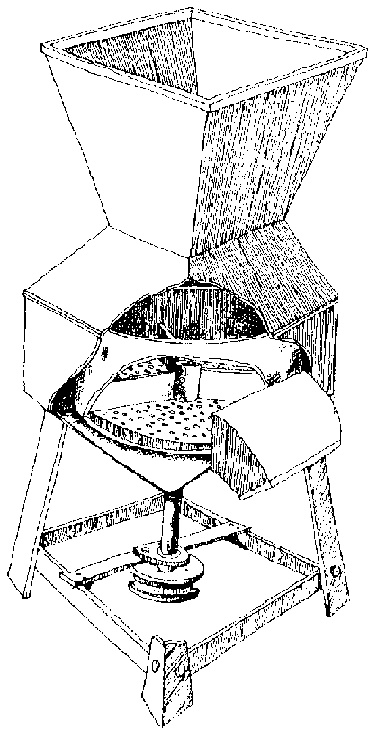
Vertical drum grater
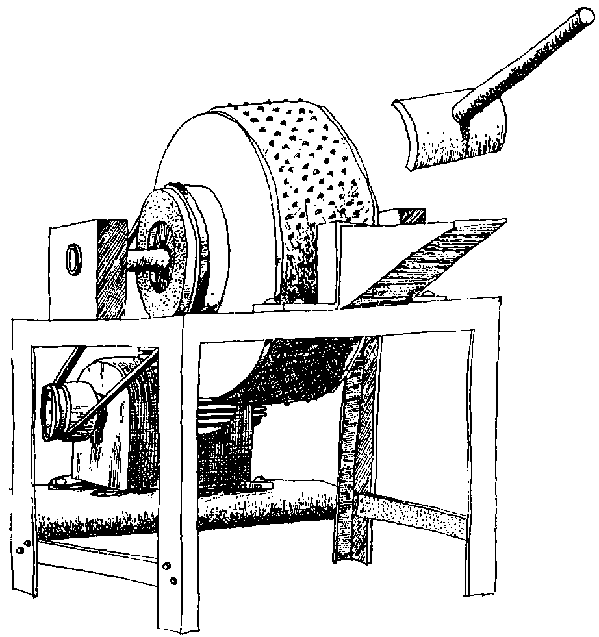
Pedal grater
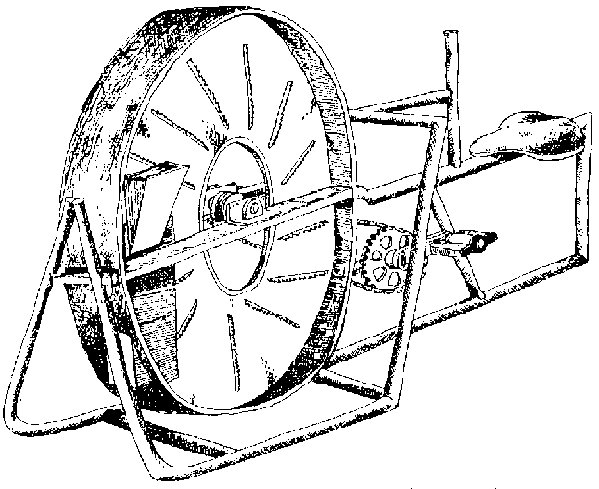
The body of these graters can of wood, galvanized metal sheet, mild steel or aluminium. The inside parts of the hopper and the chute should not have exposed steel (iron) because iron causes a bluish tinge to develop on the grated mash. Where the hopper or the grating cylinders are made of wood, they should be lined with aluminium or galvanized sheeting to make thorough cleaning easier.
5.1.2.2 Fermentation and de-watering
- Traditional method
In the traditional operations fermentation and pressing (de-watering) are done in one operation. The grated mash is packed inside baskets, jute bags or perforated plastic sacks and left to ferment for 1-4 days. The duration of the operation affects the colour, taste and texture of the gari. This duration can be reduced by seeding the freshly grated mash with previously fermented liquor as a starter, provided that it can be mixed thoroughly. Fermentation takes place in two phases. Initially the starch in the roots is hydrolysed by Corynebacterium to give sugars. These are metabolised to organic acids which hydrolyse the cyanogenic glucosides in the cassava and releases HCN. When sufficient acid has been formed the second phase, characterised by Geotrichum candida growth, begins. From the sugars the mould produces the aldehydes and esters that give gari its typical flavour (Bruisma et al 1983). During dewatering some soluble cyanide and organic acid is removed with the press liquor It also contains some starch and may be used as a base for stews and soups or the starch can be recovered by allowing the liquor to settle and decanting off the liquid.
Figure 5.6: Traditional method of pressing and fermentation (Muchnik and Vinck 1984)
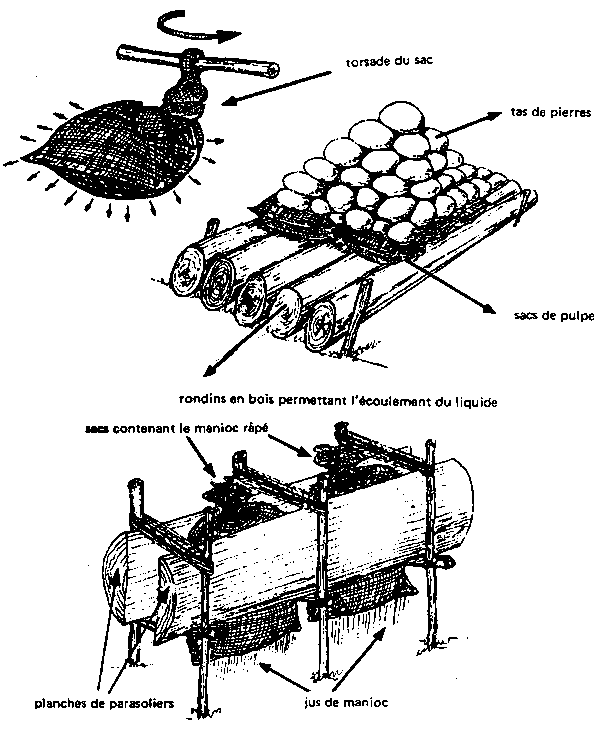
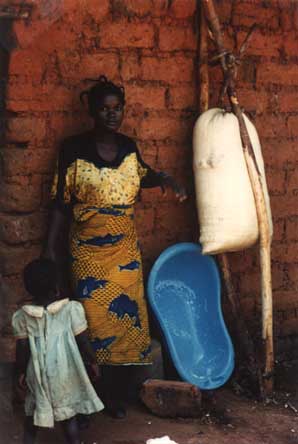
During the fermentation period the container is put under pressure by piling heavy stones on it, by strongly twisting the neck of the sacks and pressing the bag or sack between wooden poles tightened by ropes (Figure 5.6). In the latter cases the bag or sack is re-tightened every day as the liquor flows out of the cassava mash. Neither of these methods is considered as effective as the tipiti as used in South America. In this case the mash is held in a tube of a rather complicated basket weave, the diameter of which expands as it is compressed and shrinks as the tube is extended. One end of the tipiti is secured high in a tree and the other end is fastened to a lever which is subjected to a heavy downward pull by ropes, heavy stones or even by somebody sitting on it (Cock 1985).
- Improved or small commercial methods
In larger scale operations pressing takes place after fermentation. The grated mash is left to ferment for one to four days in its container. Pressing is done using one of a number of designs of screw or hydraulic press which need access to simple workshops for their construction (Figure 5.7 a and b). The Technology Consultancy Centre in Ghana developed a parallel board press in which a pulp filled bag is placed between two parallel boards which are screwed together to apply pressure to the bag. This idea has been extended to a screw press which can take several bags, but its construction requires heavy metal components. Some authorities consider it will normally take 20-30 minutes for the grated mash to reach the required level of 45%-50% moisture content (Muchnik and Vinck 1984, Flach 1990, Bencini, 1991), but others suggest that in the larger presses it may take three to four hours (ITGD 1993).
Figure 5.7 Examples of improved pressing methods
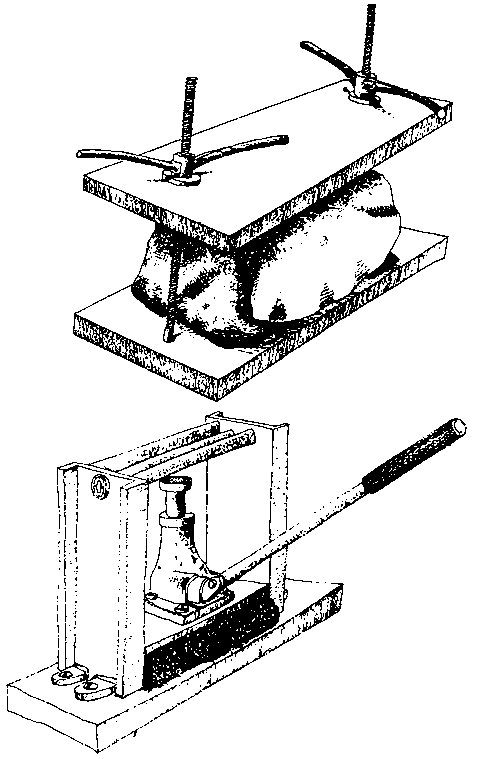
5.1.2.3 Sieving
After pressing the de-watered cassava mash is a solid cake which has to be broken up and sieved to remove the large lumps and fibre (from the central vascular strands) and to obtain an homogenous product. Uniform particle size is important because it makes for a more uniform roasting of individual particles during the frying operation, smaller particles taking less time and less energy in roasting.
Traditionally sieving is done manually using sieves made from palm leaves, bamboo or raffia cane. The sieving operation is not very difficult or arduous compared to some of the other gari processing operations. Perhaps for this reason there is little advanced sieving equipment at village level but mechanical sieves are included even in small commercial operations. Sieves are usually single or double screen trays which oscillate by means of an eccentric cam driven by small electric motor or powered by some means from the engine driving the plant.
5.1.2.4 Frying and drying
- Traditional method
Garification and drying are combined in the "frying" of the gari. At village level gari is fried in shallow cast-iron pans, or in the more traditional areas in earthenware pans, over an open wood fire (Figure 5.8). The sieved cassava mash is spread thinly in the pan in 2-3kg batches. A piece of calabash is often used to press the mash against the hot surface of the pan but it must be scraped quickly and stirred constantly to keep the material moving to prevent it burning until frying is completed when it reaches a temperature of 80° to 85°C. The rapid heating partially gelatinises the gari which is dried during the operation of frying. The process takes 30-35 minutes, with the moisture content of the final product reduced to about 18% (Muchnik and Vivier 1984, Bencini 1991).
Gari frying is a complex procedure which, in traditional processing, depends for its success almost entirely on the skill of the operator. Simply stirring the cassava mash over a fire could yield a product which may look like gari but will not be acceptable to consumers. Assessing the point at which the grains are completely gelatinized and the frying complete is a very subjective judgement and depends on the experience and skill of the operator. Experienced gari processors know when garification is complete simply by the appearance of the particles and by the feel of the texture whilst stirring.
A traditional fireplace consists of three large stones supporting the frying pan. This causes a great deal of discomfort to the operators due to exposure to heat and smoke from the fire and steam from the wet cassava mash. At the same time the system is very inefficient in its use of fuel, energy consumption per unit of dried gari is considered to be very high. Even enclosing the fire on three sides will improve fuel consumption and reduce the smoke blowing into the faces of the operator. The inefficiency of frying and firewood consumption are the most important issues in traditional gari production that need to be addressed most urgently.
The FAO post-harvest project in Cameroon introduced improved fireplaces for the frying operation (Figure 5.9) consisting of an elongated fireplace built of burnt-clay bricks and with a three metres high chimney at one end to remove smoke and fumes from the fire. The traditional cast iron pans for frying are set into the top of the fire place. The improved fireplace are said to reduce wood consumption by 55% and the frying time by about half.
Another development of note is the "village gari frying stand" developed by the Rural Agro-Industrial Development Scheme in Nigeria. It is a rectangular tray roaster with a thick-walled aluminium frying pan. Coal is the recommended fuel, but wood or sawdust can also be used. A chimney helps draw air over the fire which reduces the effects of smoke and heat on the operator. A long wooden stirrer or rake is used to turn the gari and prevent it burning. It can be used indoors or outdoors as required and although expensive it is claimed to need very little maintenance.
Figure 5.8 Traditional fireplaces for gari frying (Source: A. Diop)
Figure 5.9 Improved methods of manual gari frying (Source: Amoa-Awua and Djokoto, 1991)
Village gari frying stand
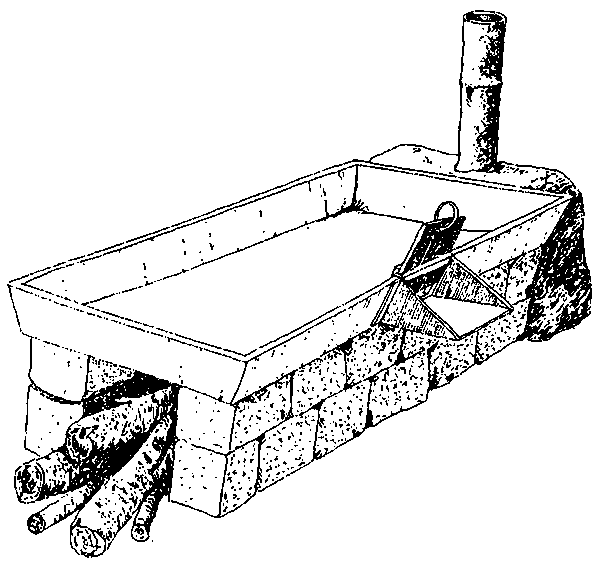
Figure 5.10 Semi-mechanized gari processing plant
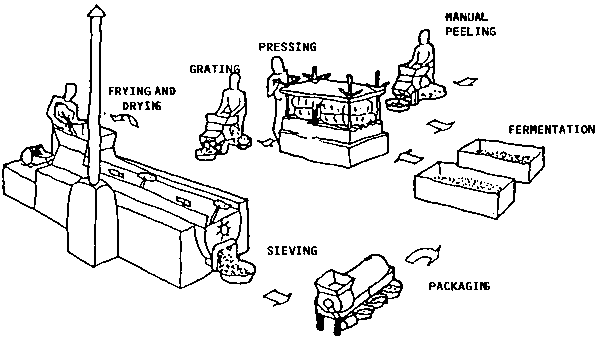
- Mechanised frying and drying
A mechanical "garifier" or a mechanised system of frying and drying usually takes the form of a mild-steel drum or trough with rotary rakes and paddles fixed to a steel shaft slowly rotating on the axis of the drum. The rakes or paddles sweep the gelatinising mash from the trough wall to prevent sticking and burning and at the same time move the material through the length of the garifier which is frequently inclined from the feeding hopper towards the discharge sprout. In a design of the Federal Institute of Industrial Research, Oshodi (FIIRO) in Nigeria a gas or wood fire below the hopper produces a wall temperature of about 250°C with the hot gasses contained within a housing of mudblocks or burnt-clay bricks. The cassava mash gelatinizes while being moved over the heated surface of the metal trough which takes about 15 minutes. The gelatinized cassava is further dried and is discharged at about 10% moisture content, suitable for long term storage in plastic bags. The machine has been on trial in several countries and the output was established at 100 kg/hour of dried gari.
Farinha de mandioca, as it is called in Brazil, is a processed cassava product particularly popular in the north-east of the country. Originally it was a food product developed over several centuries by the Indians of tropical America as a process for detoxifying bitter cassava and storing it for longer periods than was possible with fresh cassava. It is a product quite similar to gari, with the same individual operations involved in its production except that the fermentation time is shorter. There are indications that gari production was introduced in Africa by freed slaves returning from Brazil, bringing the knowledge of farinha production with them.
The traditional technology of farinha production has developed in line with the need to feed a rapidly growing urban population. The Portuguese introduced machinery which adapted well to the traditional system, notably for the grating and pressing operations. Now in Brazil, two distinct farinha production systems coexist, farina grossa and farina d'agua. Both processes are essentially the same except that in the latter the roots are submerged in pools of water for several days before peeling (Muchnik and Vinck 1984, Cock 1985).
Casas de farina, (Table 5.3) are informal, small scale family enterprises operating close to supplies of raw material. They use family labour and produce an average of 150kg per day for both domestic consumption and for marketing. The only mechanised operation is grating. Over 70,000 casas de farina are estimated to be operating in the north-east of Brazil. Both small and medium sized fully mechanised factories have been established to respond to the large and increasing demand from the urban markets that the casas de farina alone cannot satisfy. As long ago as 1970, 880 of these factories were said to be in operation.
Cassava bread, which is also called cassavae in the francophone Caribbean countries and casabe in Spanish Caribbean countries, is a white, flat, circular, porous food product made by baking moist cassava mash. It is a very popular food in South and Central America and the Caribbean.
Table 5.3 Comparison of the characteristics of casas de farinha and the farinha factories (Adapted from Muchnik and Vinck, 1984).
|
|
Casas de farinha |
Small and medium scale factories |
|
Number of units |
70,000 to 80,000 (estimate) |
1,248 (based on survey in 1970) |
|
Linkage between production and processing |
Based on small family enterprises, with supply of raw material from own production; cassava production and processing constitute a single economic unit. |
Supply based on purchases of raw material. Clear separation between raw material production and processing. |
|
Social organization of production |
Based on family labour; hired labour rather seldom; women and men participate in production, each with distinct tasks |
Small and Medium size enterprises with paid labour. |
|
Destination of final product |
25 to 50% for home consumption |
All production output destined to urban markets |
|
Capacity of units (tons of fresh cassava/day) |
0.2 to 1 |
3 to 60 |
|
Output (kg farinha/kg cassava) |
0.25 |
0.30 |
|
Investments (US$/t cassava) |
2,000 to 3,000 (based on 1979 data) |
15,000 to 20,000 (based on 1981 data) |
|
Productivity(kg/day/person.) |
10 to 20 |
150 to 400 |
The bread is made by spreading a layer of non-fermented cassava mash, produced in the same process as gari, (peeling fresh roots, grating, pressing and sieving but not fermented), over a heated metal or ceramic plate and baking it on both sides (Figure 5.11) at a temperature of about 160°C. Some processors sprinkle cassava mash on the metal plate and if it turns brown, then it is considered to be at the proper temperature. After baking the fresh cassava bread is sun-dried on raised platforms for few hour to improve its keeping quality, before being packed in paper or polyethylene bags for marketing, which is frequently sold in the retail market directly from the bakers and traders vehicles. Some processors may add salt and peanut paste or garlic before baking (Carrizales, 1991).
Figure 5.11 The baking and retailing of cassava bread
Attieke is a fermented and gelatinized cassava meal which has its origins in the south of Côte d'Ivoire, but which is now the most popular cassava product in the country. In 1984 the consumption of attieke in Abidjan alone was estimated at 70-80 tons per day (Muchnik and Vinck 1984) and the market demand has continued to grow at a considerable rate. The demand is largely met by an army of thousands of women processors and traders. Attieke is generally consumed with meat, incorporated into a vegetable sauce or mixed with milk.
The operations involved in its production are essentially the same as for gari; peeling and washing, chopping (into 3-4cm cubes), mashing or grating, fermenting, de-watering, sieving, granulating, drying and steaming. The production process is very long and at times tedious, most of the operations at present still being done by hand except for mashing.
5.1.5.1 Mashing and fermentation
Traditionally, mashing is done with a mortar and pestle or using hand graters similar to those for gari processing. Now most of the processors involved in the commercial production of attieke use machines, generally hammer mills, on a toll basis for mashing the cassava cubes. A starter to accelerate fermentation, made by boiling and fermenting cassava anaerobically i.e. inside a plastic bag, is added during mashing in the proportion of 5% to 10% by weight. About 1% by weight of oil palm is also added during this operation.
5.1.5.2 Dewatering granulating and gelatinising
The mashed cassava is kept in large baskets lined with jute and left to ferment for 10-15 hours before being de-watered using similar methods as in the case of gari. The de-watered cassava mash, which has a moisture content of 55% to 60%, is hand sieved and then granulated into round and smooth particles by continuous circular hand stirring movements. This operation is very slow with an output of only about 5 kg/hour per person. The grains obtained are sun-dried for about an hour.
After this short drying period, which may in some cases be omitted, the grains are steamed for about 30 minutes by putting the batch of granules inside a steamer. Often this is only a tin container with holes punched in the bottom and placed over a pot of boiling water with the join between the pot and the steamer sealed with wet clay. The grains are stirred with a spatula from time to time to prevent them from sticking. When they are completely gelatinised they turn yellowish and translucent
The moisture content of attieke is greater than 50%, and its shelf life is only two to four days. Since the early 1980s attempts have been made to produce attieke at the level of an industrial plant at Toumodi, Côte d'Ivoire. It aims to produce two tons of attieke and two tons of cassava flour per day. Whilst the technical aspects of the production have reportedly been solved and it is now considered possible to produce attieke with a moisture content of 8% to 10%, with a shelf life of several months (Muchnik and Vinck, 1984), there remains the problems of the product's acceptability by traders and consumers and its economic competitiveness against traditional attieke and imported cereals.
5.2.1 Traditional methods
5.2.2 Improved methods of production of dehydrated chips
In contrast to cassava of which a large proportion is consumed in a processed form, other roots and tubers (yams, potatoes, sweet potatoes and cocoyams) are normally stored and consumed as fresh produce. But on some occasions they also are processed into dried chips with the aim of prolonging the storage life, especially for that portion of the crop which has been affected by injuries or diseases.
Many simple methods have been devised based on local resources to extend the storage life of roots and tubers. At family and village levels, the fresh or precooked roots or tubers are simply peeled, cut into chips and sun-dried by being spread out in the open, on a mat or any clean surface. Drying may take up to one week or more, depending on the weather. The dried chips are ground into flour before being incorporated into the traditional foods. Yams in Nigeria, potatoes in Peru, sweet potatoes in Cameroon and Tanzania are traditionally processed in this way, the smaller tubers or those damaged or partially decayed being particularly selected for the purpose.
In order to satisfy the demand by urban consumers for a high quality product the same considerations apply to the production of high quality dried chips or flakes as in the natural drying of cassava chips (section 5.1.1). The improved methods for drying cassava chips have been applied to the drying of yams, potatoes, sweet potatoes and cocoyams. But dried chips of these roots and tubers can be affected by discolouring compounds which do not occur in cassava. The discoloration of the dried chips occurs in three ways (Straw and Booth, undated):
· Enzymatic darkening,
· After-cooking darkening,
· Browning during drying and storage.Enzymatic darkening is caused by the oxidation of phenolic compounds resulting in a brown to blue-black discoloration which affects the quality and appearance of the final product. Cooking before peeling and slicing will destroy the enzyme and prevent this type of discoloration. If it is not possible to cook the chips immediately after slicing immersing the chips in water helps to slow down the enzymatic reaction, adding salt (3% w/w) to the water will further slow down the reaction. When the freshly cut chips have to be kept for prolonged period a preferred treatment is dipping for five minutes in a 0.1-0.2% sodium bisulphite solution, or 10 minutes in a 0.5% sodium metabisulphite solution.
After-cooking darkening is the result of the oxidation of ferrous iron present in the tuber to ferric iron. Roots and tubers chips which are still warm after being boiled, parboiled or blanched should not be left exposed to air but should be cooled as quickly as possible, for example by immersion cold water. Lowering the pH also prevents the oxidation taking place; in practice this is done by dipping the chip in a solution of 0.4% citric acid.
Browning usually takes place during the drying and storage of the chips. This is the result of the reducing sugar combining with free amino acids. The reaction occurs more rapidly at temperatures above 55°C. It is, therefore, important to keep the drying temperature as low as possible.
5.2.2.1 The potato processing technology developed by CIP
CIP has developed simple processing machinery for the production of dehydrated potatoes, including a washer, peeler, slicer and dryer. The peeler is a metallic cylinder rotating on a horizontal axis. The cylinder is punched from the outside at about 7 mm centres leaving jagged raised flanges inside creating a rough abrasive surface. The cylinder is loaded with potatoes and rotated at about 60 revolutions per minute and the rough internal surface effectively scrapes the peel from the potatoes (Figures 5.12). Water is fed into the cylinder to wash out the peelings. The peeler can be turned by hand or a small motor. A batch of 20 kg takes about 20 minutes.
Figure 5.12 CIP potato hand washer and motorised peeler (Straw and Booth, undated)
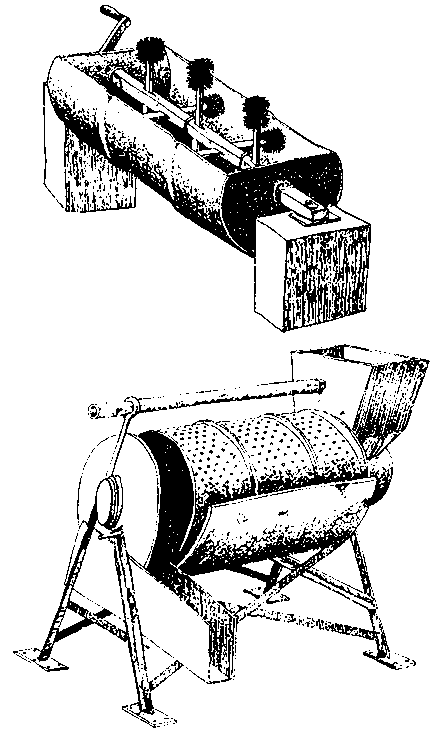
The potatoes are cooked by steaming or are blanched before being sliced and dried. The CIP slicing machine has been modified and is successfully used as a cassava chipper (section 5.1.1.2, fig 5.1) For potatoes it comprises a rotating steel disc with protruding cutting blades that cut potato slices about 2 mm thick. It was designed to be hand operated and it is claimed has an output of 150 kg/hr but this is more likely to be achieved when the machine is modified for motor drive.
The drier is simply a range of two-tier wooden racks inclined at an angle of 30 degrees to the prevailing wind. The racks hold drying trays containing the loosely spread potato slices. They are intended to be built inside a structure, covered with clear plastic, effectively a simple solar drier, and surrounded by screens in the hope of keeping out insects and birds, but sufficiently open to allow free passage of air. This simple dryer creates internal temperatures 15-20°C warmer than ambient. The drying of the slices down to 10% moisture content is done in 14-18 hours depending on weather conditions.
5.2.2.2 Drying sweet potatoes in Cameroon
An FAO post-harvest project in Cameroon introduced an improved method for the dehydration of roots and tubers which was adapted from the CIP design. It was intended for use at village level and involved washing, peeling, slicing, blanching, cooling and drying.
The principle modification is in the design of the washer-peeler. This is made from a 200-litre capacity metal drum. The inside surface of the drum is covered with abrasive carborundum grits made up of a layer of sifted river-sand followed by a layer of silicon carbide grit No 12. This gives a very abrasive surface that very effectively scrapes the peel from the tubers. The drum is carried on a steel pipe passing through the horizontal axis of the drum which rotates about this pipe. The pipe is perforated and water is passed though it into the drum to wash the potatoes and remove the peelings. The drum and axle are mounted on a suitable framework. It is rotated by hand at about 60 RPM, with a batch of 20 kg and has a capacity of about 250 kg/hr.
The bicycle-operated slicer is a modified version that developed by the Society for Development of Appropriate Technology (SOTEC) in Bareilly, India.
Blanching of the slices is done by dipping the product for five minutes in boiling water to which some citric acid and sodium metabisulphite is added. After cooling in cold water baths, the slices are spread to dry on elevated wooden platforms. Drying normally takes one to two days depending on weather conditions.